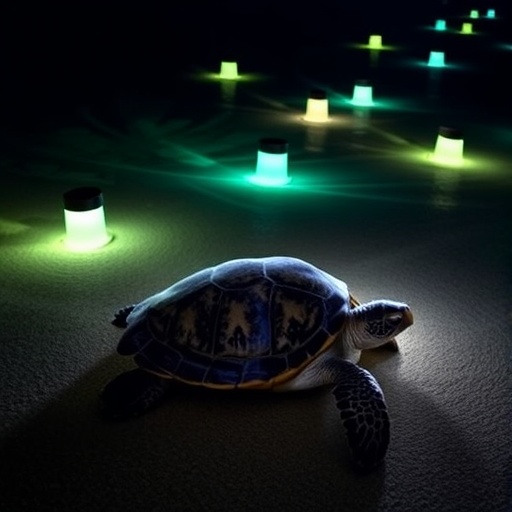In a groundbreaking collaboration between marine biologists and coastal fishers, a novel solution has emerged to significantly reduce sea turtle bycatch in gillnet fisheries—a major threat to these endangered marine reptiles. Researchers from Arizona State University (ASU), alongside seasoned fishers from Mexico’s Gulf of California, have developed and tested solar-powered LED buoys designed to integrate seamlessly into existing fishing gear, offering a sustainable, practical, and highly effective deterrent for sea turtles. This innovation is poised to revolutionize the way small-scale fisheries operate while safeguarding vulnerable marine species critical to ocean health.
Sea turtle bycatch—the unintended capture of turtles in fishing nets—has long posed a critical conservation challenge. Traditional mitigation methods, such as equipping nets with battery-powered lights, have demonstrated efficacy in reducing bycatch but suffer from significant logistical drawbacks. Batteries degrade quickly, entail costly replacements, and pose environmental disposal concerns. Additionally, conventional lights can be cumbersome, heavy, and prone to snagging, thereby impeding fishers’ work and reducing adoption rates. Overcoming these hurdles demanded a fresh approach centered on durability, cost-effectiveness, and ease of use.
The ASU-led research team, under the guidance of marine biologist Jesse Senko, pursued a transformative concept: harnessing solar energy to power LED lights embedded within buoy-like devices threaded onto the net’s float line. These compact, lightweight units flash intermittently to maximize battery life, maintaining functionality for more than five days without direct sunlight. Their design counters the common issues of weight and snagging, enabling unimpeded deployment and retrieval during fishing operations.
Field experiments conducted in Mexico’s Gulf of California revealed remarkable outcomes. The illuminated nets demonstrated a 63% reduction in sea turtle bycatch compared to unlit control nets, a significant conservation milestone. Importantly, the lighted buoys did not compromise the fishers’ catch. On the contrary, although not statistically conclusive, there was an observed increase in the catch rates of yellowtail fish, the targeted species. These findings affirm that solar-powered illumination can harmonize ecological stewardship with the economic realities of coastal fisheries.
Senko highlights the dual benefits of this technology: “We are witnessing a win-win scenario where the lights not only last substantially longer than battery-powered alternatives but also effectively deter turtles from becoming entangled.” This breakthrough addresses previous practical barriers that discouraged widespread uptake of lighted fishing nets, signaling a potential paradigm shift in bycatch mitigation.
Fishing gear entanglement represents a primary driver of population declines in endangered sea turtles, alongside threats from climate change, pollution, habitat destruction, and emergent diseases. Despite encouraging signs of slow recovery among certain turtle populations, their numbers remain only a fraction of historical baselines. Protecting turtles is pivotal for preserving marine ecosystems, where these ancient species fulfill roles such as maintaining seagrass bed health and contributing to nutrient cycling critical for ocean resiliency.
Acknowledging the stakes, Senko’s lab prioritizes collaboration with fishing communities to craft pragmatic solutions that reduce harm to sea turtles, sharks, and other at-risk species. This approach ensures that interventions align with fishers’ operational needs, fostering broader acceptance and real-world application. In North Carolina, similar collaborative efforts are underway to assess solar-powered lights’ efficacy in reducing bycatch within pound nets, employing underwater video technologies to elucidate sea turtle behavioral responses to illuminated nets.
Small-scale coastal fisheries supply nearly half of the global seafood demand and underpin food security and livelihoods in countless communities. Innovations like solar-powered illuminated buoys reflect the potential impact of fishers’ traditional knowledge fused with scientific expertise. In this project, brothers Juan Pablo and Felipe Cuevas Amador, veteran fishers from Baja California Sur, played an instrumental role by providing on-the-ground insights and iterative feedback to refine the lighted buoy design, underscoring the importance of inclusive research methodologies.
“When our ideas are incorporated, we feel empowered to use and promote the technology within our community,” stated Juan Pablo Cuevas Amador. Such fisher-driven innovation not only enhances adoption but also accelerates dissemination of effective conservation tools across regions. Following the study, the Cuevas Amador brothers requested to retain the solar-powered buoys for their own fishing operations, citing decreased time and effort spent untangling protected turtles—a testament to the gear’s practicality and value.
Currently, Senko and colleagues are collaborating with Fishtek Marine, a manufacturer specializing in fishing technologies, to develop commercial versions of these solar-powered lighted buoys. The researchers anticipate availability within two to three years, contingent upon continued testing and scaling. They envision that conservation groups and policy makers could subsidize adoption costs, facilitating widespread distribution among fishing communities and maximizing conservation impact.
Future research will delve deeper into understanding the behavioral mechanisms by which flashing light deters sea turtles, with the goal of optimizing light patterns and configurations to enhance effectiveness. “A 63% reduction in bycatch is an excellent foundation,” Senko noted. “The aspiration now is to refine this technology to achieve reductions closer to 95%, thereby nearly eliminating turtle entanglement in gillnet fisheries.”
This pioneering work exemplifies how integrating renewable energy technology with community science and conservation goals can produce scalable solutions for marine biodiversity protection. By improving fishing gear sustainability without sacrificing economic viability, solar-powered illuminated buoys chart a promising path toward resilient fisheries and thriving oceans.
Subject of Research: Animals
Article Title: Harnessing solar energy to reduce sea turtle bycatch
News Publication Date: 15-Oct-2025
Web References:
– https://senkolab.org/
– https://oceans.asu.edu/
– http://dx.doi.org/10.1111/conl.13151
– https://www.fishtekmarine.com/
References:
Senko, J., Cuevas Amador, J. P., & Cuevas Amador, F., et al. (2025). Harnessing solar energy to reduce sea turtle bycatch. Conservation Letters. DOI: 10.1111/conl.13151
Image Credits: Photo by Lindsay Lauckner Gundlock/Arizona State University
Keywords:
– Conservation biology
– Fisheries management
– Marine conservation
– Marine life
– Marine biology




